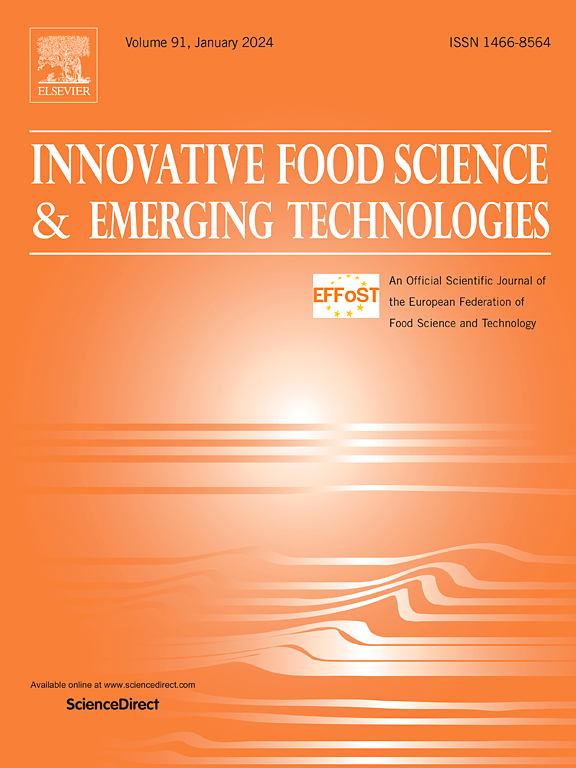Effect of microwave irradiation on the functional properties, digestion behavior, and structural characteristics of protein isolate from black beans (Phaseolus vulgaris L.)
IF 6.3
1区 农林科学
Q1 FOOD SCIENCE & TECHNOLOGY
Innovative Food Science & Emerging Technologies
Pub Date : 2025-02-10
DOI:10.1016/j.ifset.2025.103951
引用次数: 0
Abstract
Inspired by the potential of underutilized legumes for addressing present and future food security challenges, this study aimed to explore the effects of microwave irradiation (MI) (100, 300, 450, 600, and 800 W) for 2 min on the functional, structural, and rheological characteristics of black bean protein isolates (BBPIs). Scanning electron microscopy of the microwave-irradiated BBPIs revealed a distinct microstructure characterized by larger aggregates than the control BBPIs. Moreover, BBPIs treated with MI presented excellent emulsion activity index (0.55–0.98) and stability index (0.35–0.71 min), with the lowest turbidity index (0.09–0.12). SDS-PAGE analysis revealed that the profiles of the microwave-irradiated BBPI samples were similar to those of the control BBPIs. Differential scanning calorimetry and thermogravimetric analysis revealed that all the MI-treated BBPIs had variations in denaturation temperature and weight loss. Rheological analysis indicated that the gelation temperature for all BBPI samples was approximately 90 °C. The optimal MI condition (450 W for 2 min) had the highest free sulfhydryl content, surface hydrophobicity, and improved the protein digestibility of BBPI dispersions among all the samples. Microwave treatment at 450 W improved the hydrophobic amino acid content, leading to an overall increase in the total amino acid content of BBPIs compared to the control sample. The present study details how varying microwave irradiation results in distinct final properties of BBPIs, enabling their use and customization for various food systems.

微波辐照对黑豆分离蛋白功能特性、消化行为及结构特征的影响
受未充分利用的豆类在解决当前和未来粮食安全挑战方面的潜力的启发,本研究旨在探讨微波辐照(100、300、450、600和800 W) 2分钟对黑豆分离蛋白(bbpi)功能、结构和流变特性的影响。微波辐照bbpi的扫描电镜显示其微观结构明显,团聚体比对照bbpi大。此外,经MI处理的bbpi具有优异的乳化活性指数(0.55 ~ 0.98)和稳定性指数(0.35 ~ 0.71 min),浊度指数最低(0.09 ~ 0.12)。SDS-PAGE分析显示微波辐照后的BBPI样品与对照BBPI相似。差示扫描量热法和热重分析显示,所有经mi处理的bbpi在变性温度和失重方面都有变化。流变学分析表明,所有BBPI样品的凝胶化温度约为90℃。在450 W、2 min条件下,BBPI分散体的游离巯基含量和表面疏水性最高,蛋白质消化率也有所提高。450w微波处理提高了疏水氨基酸含量,导致bbpi的总氨基酸含量比对照样品总体增加。本研究详细介绍了不同的微波辐照如何导致bbpi的不同最终特性,使其能够用于各种食品系统。
本文章由计算机程序翻译,如有差异,请以英文原文为准。
求助全文
约1分钟内获得全文
求助全文
来源期刊
CiteScore
12.00
自引率
6.10%
发文量
259
审稿时长
25 days
期刊介绍:
Innovative Food Science and Emerging Technologies (IFSET) aims to provide the highest quality original contributions and few, mainly upon invitation, reviews on and highly innovative developments in food science and emerging food process technologies. The significance of the results either for the science community or for industrial R&D groups must be specified. Papers submitted must be of highest scientific quality and only those advancing current scientific knowledge and understanding or with technical relevance will be considered.

 求助内容:
求助内容: 应助结果提醒方式:
应助结果提醒方式:


